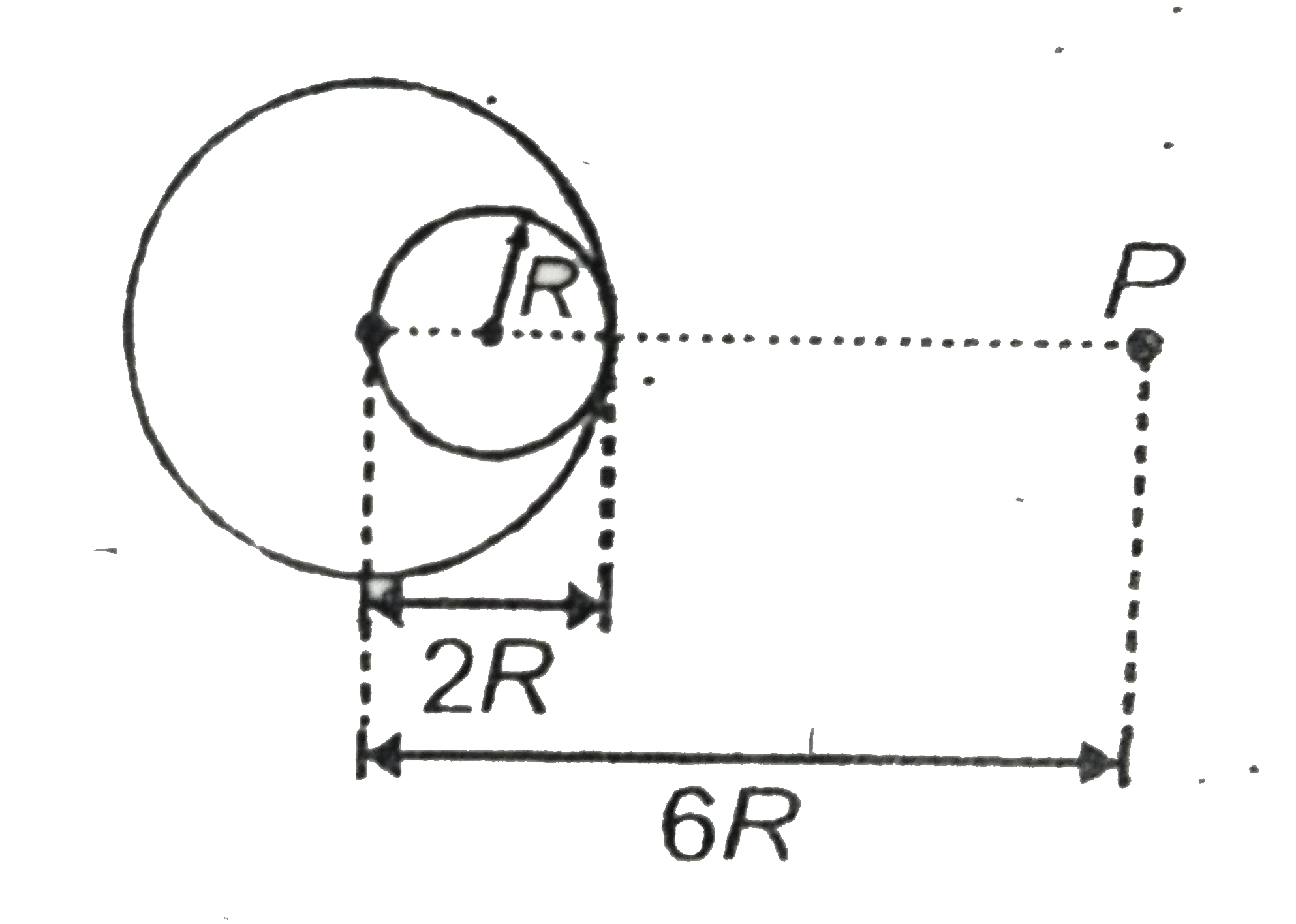A non-homogeneous sphere of radius R has the following density variation :
ρ⎧⎪⎨⎪⎩ρ0r≤R/3ρ0/2(R/3)<r≤(3R/4)ρ0/8(3R/4)<r≤R
The gravitational field at a distance 2R from the centre of the sphere is
0.1πGRρ0
0.2πGRρ0
0.3πGRρ0
0.4πGRρ0
The correct Answer is:A
To solve the problem of finding the gravitational field at a distance of 2R from the center of a non-homogeneous sphere with a given density variation, we can follow these steps:
Step 1: Understand the Density Variation
The sphere has three different density regions:
1. For 0≤r≤R3, the density ρ=ρ0.
2. For R3<r≤3R4, the density ρ=ρ02.
3. For 3R4<r≤R, the density ρ=ρ08.
Step 2: Calculate the Mass of Each Region
The mass of each region can be calculated using the formula m=ρ⋅V, where V is the volume of the sphere segment.
Mass m1 for 0≤r≤R3:
V1=43π(R3)3=43πR327=4πR381
m1=ρ0⋅V1=ρ0⋅4πR381=4πR3ρ081
Mass m2 for R3<r≤3R4:
V2=43π((3R4)3−(R3)3)
Calculating V2:
V2=43π(27R364−R327)
Finding a common denominator (which is 1728):
=43π(27⋅27R3−64R31728)=43π(729R3−64R31728)=43π(665R31728)
=4⋅665πR35184
m2=ρ02⋅V2=ρ02⋅4⋅665πR35184=1330πR3ρ05184
Mass m3 for 3R4<r≤R:
V3=43πR3−V1−V2
Calculating V3:
=43πR3−(4πR381+4⋅665πR35184)
Finding a common denominator and simplifying will yield m3.
Step 3: Total Mass of the Sphere
The total mass M of the sphere is:
M=m1+m2+m3
Step 4: Calculate the Gravitational Field at 2R
Using the formula for gravitational field g=GMr2:
g=G⋅M(2R)2=G⋅M4R2
Step 5: Substitute the Total Mass
Substituting M into the gravitational field equation gives:
g=G⋅(m1+m2+m3)4R2
Step 6: Final Calculation
After calculating M and substituting it into the gravitational field equation, we can simplify to find the final expression for g.
The sphere has three different density regions:
1. For 0≤r≤R3, the density ρ=ρ0.
2. For R3<r≤3R4, the density ρ=ρ02.
3. For 3R4<r≤R, the density ρ=ρ08.
The mass of each region can be calculated using the formula m=ρ⋅V, where V is the volume of the sphere segment.
V1=43π(R3)3=43πR327=4πR381
m1=ρ0⋅V1=ρ0⋅4πR381=4πR3ρ081
V2=43π((3R4)3−(R3)3)
Calculating V2:
V2=43π(27R364−R327)
Finding a common denominator (which is 1728):
=43π(27⋅27R3−64R31728)=43π(729R3−64R31728)=43π(665R31728)
=4⋅665πR35184
m2=ρ02⋅V2=ρ02⋅4⋅665πR35184=1330πR3ρ05184
V3=43πR3−V1−V2
Calculating V3:
=43πR3−(4πR381+4⋅665πR35184)
Finding a common denominator and simplifying will yield m3.
The total mass M of the sphere is:
M=m1+m2+m3
Using the formula for gravitational field g=GMr2:
g=G⋅M(2R)2=G⋅M4R2
Substituting M into the gravitational field equation gives:
g=G⋅(m1+m2+m3)4R2
After calculating M and substituting it into the gravitational field equation, we can simplify to find the final expression for g.
Topper's Solved these Questions
- BOOK - NCERT FINGERTPS ENGLISHCHAPTER - GRAVITATIONEXERCISE - HOTS10videos
GRAVITATION
- BOOK - NCERT FINGERTPS ENGLISHCHAPTER - GRAVITATIONEXERCISE - NCERT Exemplear Problems.8videos
GRAVITATION
- BOOK - NCERT FINGERTPS ENGLISHCHAPTER - GRAVITATIONEXERCISE - Weightlessness2videos
GRAVITATION
- BOOK - NCERT FINGERTPS ENGLISHCHAPTER - KINETIC THEORYEXERCISE - Assertion And Reason10videos
KINETIC THEORY
Similar Questions
A solid non conducting sphere of radius R has a non-uniform charge distribution of volume charge density, ρ=ρ0rR, where ρ0 is a constant and r is the distance from the centre of the sphere. Show that : (i) the total charge on the sphere is Q=πρ0R3 (ii) the electric field inside the sphere has a magnitude given by, E=KQr2R4
View SolutionTwo non-conducting solid spheres of radii R and 2R, having uniform volume charge densities ρ1 and ρ2 respectively, touch each other. The net electric field at a distance 2R from the centre of the smaller sphere, along the line joining the centres of the spheres, is zero. The ratio ρ1ρ2 can be
View SolutionThe density inside a solid sphere of radius a is given by ρ=ρ0r, where ρ0 is the density at the surface and r denotes the distance from the centre. Find the gravitational field due to this sphere at a distance 2a from its centre.
View SolutionA solid sphere of radius R1 and volume charge density ρ=ρ0r is enclosed by a hollow sphere of radius R2 with negative surface charge density σ, such that the total charge in the system is zero . ρ0 is positive constant and r is the distance from the centre of the sphere . The ratio R2/R1 is
View SolutionLet there be a spherical symmetric charge density varying as p(r)=p0rR upto r = R and ρ(r)=0 for r>R, where r is the distance from the origin. The electric field at on a distance r(r<R) from the origin is given by -
View SolutionAn insulating solid sphere of radius R has a uniformly positive charge density ρ. As a result of this uniform charge distribution there is a finite value of electric potential at the centre of the sphere, at the surface of the sphere and also at a point out side the sphere. The electric potential at infinity is zero.
Statement-1: When a charge 'q' is taken from the centre to the surface of the sphere, its potential energy changes by qρ3∈0
Statement-2 : The electric field at a distance r(r<R) from the centre of the the sphere is ρr3∈0View SolutionThe electric field at a distance 3R/2 from the centre of a charge conducting spherical shell of radius R is E. The electric field at a distance R/2 from the centre of the sphere is
View SolutionThe electric field at a distance 3R/2 from the centre of a charge conducting spherical shell of radius R is E. The electric field at a distance R/2 from the centre of the sphere is
View SolutionA sphere of radius 2R and mas M has a spherical cavity of radius R as shown in the figure. Find the value of gravitational field at a point P at a distance of 6R from centre of the sphere.
 View Solution
View SolutionFor a given uniform spherical shell of mass M and radius R find gravitational field at a distancer r from centre in following two cases (a) r≥R (b) r<R .
View Solution
